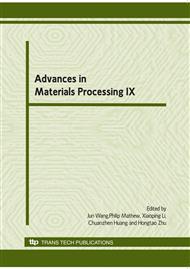p.699
p.705
p.711
p.717
p.723
p.731
p.736
p.742
p.748
Possible Chemical Bond Formation between a Carbon Nanotube and Alumina Matrix - A Quantum Mechanics Investigation
Abstract:
To improve the structural properties of engineering ceramics, carbon nanotubes have been used as a reinforcement phase to produce stronger ceramic matrix composites. This paper investigates the possible chemical bond formation between a carbon nanotube and alumina with the aid of quantum mechanics analysis. The cases with and without functionalizing the nanotubes were examined. The nanotubes were modeled by nanotube segments with hydrogen atoms added to the dangling bonds of the perimeter carbons. The cleaved ceramic (0001) surface was represented by an alumina molecule with the oxygen atoms on either end terminated with hydrogen. Methoxy radicals were used to functionalize the CNTs. The study predicts that covalent bonding between Al atoms on a cleaved single crystal alumina surface and C atoms on a nanotube are energetically favorable.
Info:
Periodical:
Pages:
723-728
Citation:
Online since:
June 2010
Authors:
Keywords:
Price:
Сopyright:
© 2010 Trans Tech Publications Ltd. All Rights Reserved
Share:
Citation:


